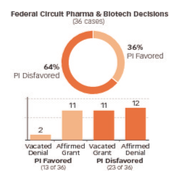Biosimilar Litigation: Lessons So Far
Pharmaceutical Executive
The case of Amgen v. Sandoz signals that preliminary injunctions will play major role in future patent disputes
Congress enacted the Biological Price Competition and Innovation Act (BPCIA) in March 2010, as part of the Affordable Care Act, creating an abbreviated FDA-approval pathway for biological products demonstrated to be “biosimilar” or “interchangeable” with a licensed biologic. The BPCIA sets forth detailed procedures for exchanging patent information between an applicant who files an abbreviated biologics license application (aBLA) under the BPCIA (referred to as a “subsection (k) applicant”) and the reference product sponsor (RPS). The statute also provides for a “notice of commercial marketing,” whereby the subsection (k) applicant “shall provide notice to the reference product sponsor not later than 180 days before the date of the first commercial marketing of the biological product licensed under subsection (k).”
The BPCIA expressly provides that the RPS may seek a preliminary injunction to prevent the applicant from making or selling its product until the court resolves patent validity, enforceability, and infringement, after it receives the notice of commercial marketing. Preliminary injunctions are likely to be important for biologics, particularly those approaching or beyond the statutory 12 years of marketing exclusivity provided to the RPS, because, unlike in small molecule abbreviated new drug application (ANDA) litigation, there is no automatic 30-month stay triggered by filing suit that prevents the FDA from approving the generic product.
With FDA’s approval of the first biosimilar product-Sandoz’s Zarxio, a biosimilar to Amgen’s Neupogen (filgrastim)-earlier this year, litigants are raising challenges to and the courts are beginning to interpret the BPCIA’s provisions. For example, the U.S. Court of Appeals for the Federal Circuit recently ruled that the BPCIA’s patent-exchange process is optional and that an applicant cannot provide an effective notice of commercial marketing until after it receives approval for its BLA.
As litigation in this area continues to develop, preliminary injunctions will play a meaningful role. In Amgen v. Sandoz, for example, the district court denied Amgen’s motion for a preliminary injunction, which Amgen filed only a month before Sandoz’s anticipated commercial launch of Zarxio. Some insight, discussed below, can be gleaned from the arguments and district court’s decision in Amgen v. Sandoz, as well as past Federal Circuit preliminary-injunction decisions affecting the industry.
Amgen v. Sandoz: The preliminary injunction
On July 24, 2014, the FDA accepted Sandoz’s aBLA filed under the BPCIA pathway to market a biosimilar copy of Amgen’s Neupogen. The BPCIA contemplates that a subsection (k) applicant will provide a copy of its BLA to the RPS, in this case Amgen, not later than 20 days after the applicant receives notification that the FDA accepted its application. This marks the beginning of the BPCIA’s patent-exchange procedures. After correspondence between the parties, however, Sandoz informed Amgen that it was declining to engage in the BPCIA’s patent-exchange process and would not disclose its aBLA. Sandoz, however, did provide Amgen with its 180 day notice of commercial marketing, despite the fact that its Zarxio product had not yet been approved by the FDA.
Amgen filed suit on Oct. 24, 2014, alleging unfair competition and conversion under California state law and patent infringement. Amgen’s state-law claims turned on the parties’ differing interpretations of the BPCIA, namely whether Sandoz’s refusal to engage in the patent-exchange process and its provision of notice of commercial marketing before it received FDA approval violated the BPCIA. Less than three months into the case, Amgen moved for the court to issue a judgment on its state-law claims. A month later, after the FDA held a public hearing regarding Zarxio and stated its intent to approve Sandoz’s product, Amgen filed a motion for a preliminary injunction seeking to stop Zarxio from entering the market at least until the court ruled on the parties’ motions for judgment.
In deciding whether to grant a preliminary injunction, courts consider four factors: (1) the moving party’s likelihood of success on the merits of its case; (2) whether irreparable harm to the moving party will ensue absent the injunction; (3) whether the balance of equities favors the injunction; and (4) the public interest.
In supporting its motion for a preliminary junction, Amgen contended that loss of the BPCIA patent-exchange procedure itself caused it irreparable harm. Amgen identified four further sources of harm from Sandoz’s “premature competition.” First, Amgen argued that Sandoz’s sales will draw sales from Amgen’s products, directly impacting Amgen’s R&D opportunities, including potential layoffs of scientists for lack of research funding. Second, Amgen identified irreparable harm to three of its emerging products because its sales and marketing workforce would be diverted from launching new products to mitigating share loss for Neupogen, as a result of Zarxio’s market entry. Third, Amgen pinpointed price erosion as an irreparable harm. Finally, Amgen alleged that its relationship with customers and goodwill would be irreparably harmed if Sandoz launched Zarxio and later withdrew it, assuming Amgen prevails in its lawsuit.
Turning to the balance of equities, Amgen argued that the potential harm to Amgen if it prevailed (i.e., loss of its rights under the BPCIA) far outweighed any harm to Sandoz if Amgen did not prevail (i.e., a slight delay in launching Zarxio). For the last factor, Amgen argued that the public interest disfavored Sandoz’s disregard of a statute “enacted to govern commercial behavior in an area as important to the national economy as healthcare.”
In response, Sandoz argued that any harm is “self-inflicted” because Amgen initially refused Sandoz’s terms for disclosing its aBLA, waited months to file an infringement suit, and waited many months more before seeking a preliminary injunction. Sandoz further argued that even if it violated the BPCIA, that does not automatically create irreparable harm. And Sandoz refuted Amgen’s alleged harm from loss of research and development, threat to goodwill, and price erosion as speculative.
Because Amgen based irreparable harm on Sandoz’s alleged violation of the BPCIA and the district court agreed with Sandoz that no violation of the BPCIA occurred, the district court found that Amgen could not show a likelihood of success. The district court further found that the company did not establish irreparable harm in the absence of an injunction, finding Amgen’s proffered harms “at best highly speculative.” The court, therefore, denied Amgen’s request for preliminary injunctive relief, and, for the same reasons it also denied Amgen’s request for an injunction pending an appeal to the Federal Circuit.
On appeal, not only did Amgen seek reversal of the district court’s decision denying its request for a preliminary injunction, Amgen also filed an emergency motion for an injunction pending appeal at the Federal Circuit. The Federal Circuit granted Amgen’s emergency motion on May 5, just days prior to Sandoz’s anticipated launch of Zarxio. The Federal Circuit issued its opinion in Amgen v. Sandoz on July 22, 2015, wherein the court held that: (1) disclosure of an aBLA was not mandatory; and (2) to be effective, a subsection (k) applicant must wait until after FDA approval to provide its 180 day notice of commercialization. Because Amgen had only sought a preliminary injunction until the district court decided the parties’ motions for judgment, and the district court had previously ruled on those motions against Amgen, the Federal Circuit dismissed as moot that aspect of Amgen’s appeal.
Case precedent
While the Federal Circuit did not weigh in on the merits of Amgen’s motion for a preliminary injunction, some insight can be gleaned from the Federal Circuit’s treatment of preliminary

injunctions in pharma and biotechnology cases generally. As shown in the chart, an informal survey reveals that the Federal Circuit disfavored the grant of a preliminary injunction in roughly 60% of biopharma cases involving preliminary injunctions. And although the Federal Circuit affirms grants, vacates grants, and affirms denials in almost equal measure, it rarely vacates a district court’s decision to deny preliminary injunctive relief.
Review of these cases show that they often turn on likelihood of success, particularly where the accused infringer cannot establish that its therapy is clinically beneficial as compared to the patentee’s product. If a patentee cannot demonstrate a likelihood of success on the merits of its case, courts will typically deny its request for preliminary injunctive relief. The same holds true for irreparable harm. However, even if likelihood of success and irreparable harm are shown, a court may deny injunctive relief if there is a critical public interest at stake.
It will be left to future cases to elucidate how courts will receive requests for preliminary injunctive relief in biosimilars litigation. But as the circumstances of Amgen v. Sandoz show, especially in cases where the biosimilar’s commercial launch might occur well before the completion of the underlying patent litigation, preliminary injunctions will play a significant role.
Mindy Ehrenfried is is an Associate; she can be reached at mindy.ehrenfried@ finnegan.com. William Raich is a Partner; he can be reached at william.raich@ finnegan.com. Both with Finnegan, Henderson, Farabow, Garrett & Dunner, LLP.

Navigating Distrust: Pharma in the Age of Social Media
February 18th 2025Ian Baer, Founder and CEO of Sooth, discusses how the growing distrust in social media will impact industry marketing strategies and the relationships between pharmaceutical companies and the patients they aim to serve. He also explains dark social, how to combat misinformation, closing the trust gap, and more.
Pfizer, GSK Gain ACIP Recommendations for RSV and Meningococcal Vaccines
April 18th 2025The Centers for Disease Control and Prevention’s Advisory Committee on Immunization Practices voted to expand access to Pfizer’s respiratory syncytial virus vaccine Abrysvo for high-risk adults in their 50s and voted in favor of GSK’s meningococcal vaccine, Penmenvy, for streamlined adolescent protection.